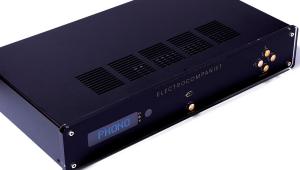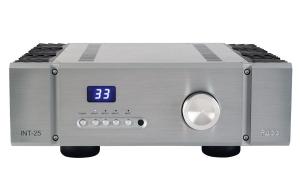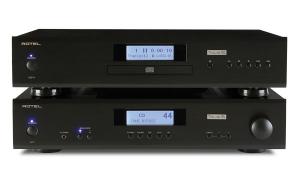Teac AI-301DA - £400

Once upon a time if you mentioned the words computer and audiophile in the same sentence you would have been chased out of town. Those days are long gone and thanks to hi-res audio downloading there’s now a turf war going on for ownership of your desktop by hi-fi manufacturers eager to cash in with products that deliver maximum sonic satisfaction for those of us who like to listen as we learn or earn.
Understanding hi-res formats can be more daunting than deciphering the Da Vinci code in Nooksack, but one thing that is incontrovertible is that owning DSD files and not having an external DAC is like owning an E-type and keeping it in the garage. One such example is the AI-301DA, which boasts a Burr-Brown PCM1795 DAC and an asynchronous USB input. It’s also a Class D amplifier with a subwoofer pre-out and has a slew of inputs that could well see the unit gainfully employed in a living room alongside a TV, DVD or CD deck.
The AI-301DA has a few other tricks up its sleeve, including a built-in headphone amplifier and aptX Bluetooth for the first time on a Teac amp. Another nice touch is that Teac provides free software, called Teac High Res Audio Player, which extracts those DSD files out of your computer and passes them on to the DAC.
If you use your computer within a USB cable’s length of the TV or CD player you’re well placed to take advantage of all of the AI-301DA’s talents. Just remember if you want to extract every last bit of sonic goodness out of any computer-stored hi-res files you need a cabled connection with the AI-301, as Bluetooth wireless is not up to maxing your hi-res music files. If Teac had opted for AirPlay as well as or instead of Bluetooth, we’d be talking about wirelessly streaming hi-res files.
Whichever setup you plump for you’ll be listening to the unit’s 80W Class D power amp, made by ICEpower of Denmark. This uses a hybrid feedback oscillating modulator and a multi-variable enhanced cascade control, which minimises heat generation sufficiently to negate the need for a cooling fan.
The amp is styled in classical component form, but has pleasingly compact dimensions (just 215mm wide). Design-wise it successfully straddles hi-fi, computer audio and living room domains without seeming too brash, too minimalistic or looking like it’s been knocked together in someone’s garage. It feels reassuringly solid and inert and has a nicely milled motor-driven volume knob.
The front power button clicks pleasingly when pressed and the input LEDs light up unambiguously to tell you which source is in use. If used with a TV or deck across a room chances are you’ll struggle to decipher the light show but you can use the dinky handset, which is plasticky but seems durable and thankfully has dedicated buttons for each input. You’ll probably also need the remote in a desktop setup as the volume level can’t be adjusted using a computer keyboard (although you can manually drag the volume slider within iTunes).
The 6.35mm headphone jack will connect your cans to a dual 100mW output (at 32ohms load) while the back of the AI-301DA provides just enough space for the slew of digital and analogue inputs comprising two pairs of RCA phonos, a digital optical input and a coaxial input, the latter two offering 24/192 and 24/96 compatibility respectively.
The heavy duty speaker terminals are banana plug-compatible and made from plastic-covered metal. A subwoofer pre-out, USB service port and USB type B completes the impressive jack pack. In asynchronous mode the latter USB eliminates jitter by bypassing the computer’s inferior internal clock.
The aforementioned Burr-Brown PCM1795 DAC eats 5.6MHz DSD and 32-bit/192kHz PCM signals for breakfast, should you choose to cook some up via the USB input. This allows native DSD bit streaming and converts 5.6MHz files directly to analogue signals without the need to first convert them to PCM, although it also supports DoP (DSD over PCM) conversion.
If using the unit for soundbar duties there’s a handy auto-on function, so turning the TV on will kickstart the amp into life from its snoozing state, and vice versa.
Using a USB connection and the Teac HR Audio Player software you may think all your hi-res troubles are over, but that is not quite the case. On a Mac the software is easy to download and install as no additional drivers are required. It’s also a cinch dragging and dropping files to create and save playlists, but (unlike other software such as Audirvana) file compatibility eschews all of Apple’s formats. So while you can play DSD (2.8 and 5.6), FLAC and MP3 via the HR Audio Player, you have to use iTunes for M4A, AIFF and ALAC, as well as DXD WAV files. You also need to manually switch the audio output to USB or back again using the computer’s sound preferences and may have to tinker with the frequency settings using the Audio MIDI utility. As such, it’s a shame the AI-301DA doesn’t have an LCD display that tells you the incoming format, bit rate and sampling frequency.
Sound quality
The AI-301DA can muster two channels at 40W (claimed) and has enough in its tank to comfortably drive a pair of speakers with an impedance between four and eight ohms. Going straight in for the kill I am blown away by the clarity and openness of my DSD collection. The violins and cellos in Vivaldi’s Concerto in D minor opus 4 no.8 Allegro have an energy and vitality that almost penetrates my joints. The mid-range simply shines and the low frequencies are mesmerisingly smooth. Compared with a standard resolution version the piece is much more beguiling and I am happy to listen to it repeatedly in a way that I’d never do otherwise.
Dropping down a resolution notch or two to a 24/96 FLAC download of Steely Dan’s Time Out Of Mind is still totally engaging with a punchiness that’s normally absent when listening through a built-in computer DAC or speakers. Donald Fagen’s vocals are airy and resonant and the percussion has an unexpected dimensionality about it that seems to come from above.
Fantasia on Greensleeves, another hi-res FLAC download, shows the AI-301DA has a deftness of touch with sumptuous strings that are immaculately timed, grabbing me by the emotional collar and carrying me away to a leafy meadow. I can almost taste the cucumber sandwiches before I am rudely awakened by a bit of head-thumping bass from Lorde and her Royals. This time I listen via Bluetooth and as pleasingly coherent as it is, with no loose or woolly bass notes I don’t feel the same spine-tingling quality to her vocals as I do with better-quality formats.
The gap between wireless and hard-wired connections is proven by a comparison of CD and Bluetooth versions of Diana Krall’s My Love Is. The latter is decent and has plenty of verve and gusto, but there’s a small but significant increase in detail with the CD version. Krall’s seductive vocals are a touch more resonant and the double bass twangs that much more so that the long low notes hang tantalisingly as you sense the air vibrating around the strings.
Teac’s choice of a digital amplifier rather than a Class A/B one means the AI-301DA has an inherently clinical edge to its sound. This seems to matter less with higher quality sources than it does with more compressed ones, but it can be quite unforgiving with low bit-rate music streamed from Spotify or vTuner internet radio, where holes in the dynamic range are dissatisfying.
Conclusion
There’s an awful lot to like about the AI-301DA, especially the way it handles DSD files over USB by combining flawlessly with the Teac HR Audio Player software. It’s a shame the software can’t handle Apple’s own hi-res formats, but you can revert to iTunes where necessary.
The amp is excellently built, looks the part and is highly versatile in terms of its file handling and source compatibility, although its lack of AirPlay or Ethernet makes it more limited when used in a living room situation. Still, given the highly reasonable price it makes a more than compelling case for itself as a desktop amp for the computer-using audiophile generation.
LIKE: Good design; DSD handling; inputs
DISLIKE: iTunes incompatibility; clinical digital sound; no AirPlay/wi-fi
WE SAY: Superb with hi-res; versatile enough to use in the living room and compact
DETAILS
PRODUCT Teac AI-301DA
ORIGIN Japan
TYPE Integrated amplifier with USB DAC and Bluetooth
WEIGHT 2.1kg
DIMENSIONS (WxHxD) 215 x 61 x 254mm
FEATURES
• 2x 40W Class-D power amplifier
• 2.8MHz/5.6MHz DSD native playback; 32bit/192kHz hi-res
• Burr-Brown PCM1795 DAC
• aptX Bluetooth
DISTRIBUTOR Onkyo Europe
TELEPHONE +49 8142 4208141
WEBSITE teac-audio.eu
 |
Inside this month's issue:
Q Acoustics 3020c standmount loudspeakers, Perlisten R10s active subwoofer, Quad 33 and 303 pre/power amps, Acoustic Solid Vintage Full Exclusive turntable, newcomer Fell Audio Fell Amp and Fell Disc and lots, lots more...
|




















































